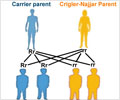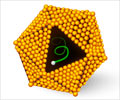Paediatric researchers have found that common practice of visual inspection (looking for yellowish eye, or skin tone) is not a reliable method to predict a newborn's risk of jaundice.
Paediatric researchers have found that common practice of visual inspection (looking for yellowish eye, or skin tone) is not a reliable method to predict a newborn's risk of jaundice.
The yellowness comes from a blood byproduct, bilirubin, and a child that develops high levels of bilirubin has a potentially serious condition called hyperbilirubinemia.Researchers have now called visual inspection an unreliable method to gauge jaundice risk and said that only infants with a total absence of visible jaundice can confidently be expected to have a very low risk of hyperbilirubinemia.
"Our study tells clinicians that our ability to estimate a baby's bilirubin level, or predict the baby's risk of developing clinically significant hyperbilirubinemia, by visually observing the extent of visual jaundice, is inadequate, and not very helpful," said study leader Ron Keren, M.D., M.P.H., a pediatrician in the Center for Pediatric Clinical Effectiveness at The Children's Hospital of Philadelphia.
The study is the first systematic analysis of jaundice assessment as a predictor of significant hyperbilirubinemia risk. It was also the largest such study, involving 522 term and late-preterm newborns.
Clinicians have long known that neonatal jaundice progresses from head to foot, as shown by yellowing of the baby's skin.
In the study, nurses used a five-point scale to grade the farthest extent of jaundice along the newborn's body.
Advertisement
An analysis of the results revealed that, while there was some correlation between the extent of jaundice as rated by the nurses and the measured bilirubin levels, the extent of jaundice could not be used to estimate the bilirubin level or to accurately predict an infant's risk of developing significant hyperbilirubinemia (defined in this study as a bilirubin level for which phototherapy is recommended).
Advertisement
The correlation between visually assessed jaundice and bilirubin level was especially weak in late-preterm infants, those at 35 to 38 weeks gestational age.
The researchers said that it is important because late-preterm infants are at greater risk of developing significant hyperbilirubinemia.
The one exception to the poor predictive value of visual assessment came in the 91 infants (17 percent of all those studied) rated by the nurses as having a complete absence of jaundice, and for whom, the actual risk of developing significant hyperbilirubinemia was extremely low, less than 1 percent.
Researchers said that even for those infants, absence of visual jaundice might require a caveat.
"Less experienced observers may be less capable of accurately assessing a complete absence of jaundice. All in all, the benefits of objective results from universal bilirubin screening may outweigh the benefit in reducing testing and costs from pursuing a selective screening approach," said the researchers.
The study appeared in the online version of Archives of Disease in Childhood-Fetal and Neonatal Edition.
Source-ANI
SRM















